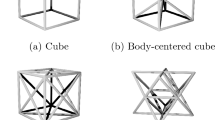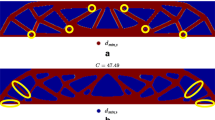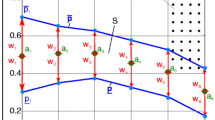Abstract
This work presents a topology optimization method for the design of programmable lattice materials whose struts can be activated/deactivated by some actuation mechanism. The proposed method simultaneously determines the spatial layout of struts in the unit cell, and two or more programs corresponding to the open/close states of the struts in order to attain desired effective properties. A high-level parametric description of the cylindrical struts in the unit cell is smoothly mapped onto a fixed mesh for analysis via the geometry projection method. Desired material symmetries are imposed by reflections with respect to the symmetry planes in the computation of the projected density. The open/close state of a strut is modeled by assigning a state variable per program to each strut, and a discreteness constraint in the optimization ensures these variables are zero or unity in the optimal design. To aid manufacturability, a no-cut constraint is imposed to preclude partial cuts of the struts by the symmetry planes or the unit cell boundaries and thus ensure that struts are whole in the optimal design. The effectiveness of the proposed method is demonstrated with examples of minimal volume design for two and three programs with target bulk moduli and for two programs with a bulk modulus target and a Poisson’s ratio target.




Similar content being viewed by others
References
Aage N, Andreassen E, Lazarov BS, Sigmund O (2017) Giga-voxel computational morphogenesis for structural design. Nature 550(7674):84
Ajdari A, Nayeb-Hashemi H, Vaziri A (2011) Dynamic crushing and energy absorption of regular, irregular and functionally graded cellular structures. Int J Solids Struct 48(3–4):506–516
Akl W, Baz A (2010) Multi-cell active acoustic metamaterial with programmable bulk modulus. J intell Mater Syst Struct 21(5):541–556
Allison J (2004) Complex system optimization: a review of analytical target cascading, collaborative optimization, and other formulations. PhD Thesis. University of Illinois at Urbana-Champaign
Ambati M, Fang N, Sun C, Zhang X (2007) Surface resonant states and superlensing in acoustic metamaterials. Phys Rev B 75(19):195447
Andreassen E, Andreasen CS (2014) How to determine composite material properties using numerical homogenization. Comput Mater Sci 83:488–495
Baz AM (2010) An active acoustic metamaterial with tunable effective density. J Vib Acoust 10(1115/1):4000983
Bückmann T, Schittny R, Thiel M, Kadic M, Milton GW, Wegener M (2014) On three-dimensional dilational elastic metamaterials. New J Phys 16(3):033032
Caloz C, Itoh T (2005) Electromagnetic metamaterials: transmission line theory and microwave applications. Wiley, Hoboken
Chen H, Chan C (2007) Acoustic cloaking in three dimensions using acoustic metamaterials. Appl Phys Lett 91(18):183518
Choi J, Lakes R (1992) Non-linear properties of polymer cellular materials with a negative Poisson’s ratio. J Mater Sci 27(17):4678–4684
Christensen J, Kadic M, Kraft O, Wegener M (2015) Vibrant times for mechanical metamaterials. MRS Commun 5(3):453–462
Coniglio S, Morlier J, Gogu C, Amargier R (2019) Generalized geometry projection: a unified approach for geometric feature based topology optimization. Arch Comput Methods Eng. https://doi.org/10.1007/s11831-019-09362-8
Cui TJ, Qi MQ, Wan X, Zhao J, Cheng Q (2014) Coding metamaterials, digital metamaterials and programmable metamaterials. Light: Sci Appl 3(10):e218–e218
Deng H, To AC (2020) Linear and nonlinear topology optimization design with projection-based ground structure method (p-gsm). Int J Numer Methods Eng 121(11):2437–2461
Engheta N, Ziolkowski RW (2006) Metamater: Phys Eng Explor. Wiley, Explorations
Evans AG, Hutchinson J, Ashby M (1998) Multifunctionality of cellular metal systems. Prog Mater Sci 43(3):171–221
Evans AG, Hutchinson JW, Fleck NA, Ashby M, Wadley H (2001) The topological design of multifunctional cellular metals. Prog Mater Sci 46(3–4):309–327
Feng S, Li M, Joo J, Kang K, Kim T, Lu T (2012) Thermomechanical properties of brazed wire-woven bulk kagome cellular metals for multifunctional applications. J Thermophys Heat Transf 26(1):66–74
Fleck Na, Deshpande V, Ashby M (2010) Micro-architectured materials: past, present and future. Proc R Soc A 466(2121):2495–2516
Florijn B, Coulais C, van Hecke M (2014) Programmable mechanical metamaterials. Phys Rev Lett 113(17):175503
Geiss MJ, Boddeti N, Weeger O, Maute K, Dunn ML (2019) Combined level-set-XFEM-density topology optimization of four-dimensional printed structures undergoing large deformation. J Mech Des 10(1115/1):4041945
Gibson LJ, Ashby MF (1999) Cellular solids: structure and properties. Cambridge University Press, Cambridge
Goodfellow I, Bengio Y, Courville A (2016) Deep learning. MIT press
Guedes J, Kikuchi N (1990) Preprocessing and postprocessing for materials based on the homogenization method with adaptive finite element methods. Comput Methods Appl Mech Eng 83(2):143–198
Gusev VE, Wright OB (2014) Double-negative flexural acoustic metamaterial. New J Phys 16(12):123053
Haghpanah B, Ebrahimi H, Mousanezhad D, Hopkins J, Vaziri A (2016) Programmable elastic metamaterials. Adv Eng Mater 18(4):643–649
Han T, Bai X, Thong JT, Li B, Qiu CW (2014) Full control and manipulation of heat signatures: cloaking, camouflage and thermal metamaterials. Adv Mater 26(11):1731–1734
Hao J, Wang J, Liu X, Padilla WJ, Zhou L, Qiu M (2010) High performance optical absorber based on a plasmonic metamaterial. Appl Phys Lett 96(25):251104
Hohe J, Hardenacke V, Fascio V, Girard Y, Baumeister J, Stöbener K, Weise J et al (2012) Numerical and experimental design of graded cellular sandwich cores for multi-functional aerospace applications. Mater Des 39:20–32
Jia Z, Liu F, Jiang X, Wang L (2020) Engineering lattice metamaterials for extreme property, programmability, and multifunctionality. J Appl Phys 127(15):150901
Ju L, Geng B, Horng J, Girit C, Martin M, Hao Z, Bechtel HA et al (2011) Graphene plasmonics for tunable terahertz metamaterials. Nat Nanotechnol 6(10):630–634
Kang Z, James KA (2020) Thermomechanical topology optimization of shape-memory alloy structures using a transient bilevel adjoint method. Int J Numer Methods Eng 121(11):2558–2580
Kang Z, Wang Y (2013) Integrated topology optimization with embedded movable holes based on combined description by material density and level sets. Comput Methods Appl Mech Eng 255:1–13
Kazemi H, Vaziri A, Norato JA (2018) Topology optimization of structures made of discrete geometric components with different materials. J Mech Des 140(11):111401
Kazemi H, Vaziri A, Norato JA (2020) Multi-material topology optimization of lattice structures using geometry projection. Comput Methods Appl Mech Eng 363:112895
Li J, Chan CT (2004) Double-negative acoustic metamaterial. Phys Rev E 70(5):055602
Lim TC (2014a) Buckling and vibration of circular auxetic plates. J Eng Mater Technol 136(2):021007
Lim TC (2014b) Vibration of thick auxetic plates. Mech Res Commun 61:60–66
Liu X, Tyler T, Starr T, Starr AF, Jokerst NM, Padilla WJ (2011) Taming the blackbody with infrared metamaterials as selective thermal emitters. Phys Rev Lett 107(4):045901
Lu T, Stone HA, Ashby M (1998) Heat transfer in open-cell metal foams. Acta Mater 46(10):3619–3635
Lu MH, Feng L, Chen YF (2009) Phononic crystals and acoustic metamaterials. Mater today 12(12):34–42
Ma Y, Scarpa F, Zhang D, Zhu B, Chen L, Hong J (2013) A nonlinear auxetic structural vibration damper with metal rubber particles. Smart Mater Struct 22(8):084012
Maiti S, Gibson L, Ashby M (1984) Deformation and energy absorption diagrams for cellular solids. Acta Metall 32(11):1963–1975
Majidi C, Wood RJ (2010) Tunable elastic stiffness with microconfined magnetorheological domains at low magnetic field. Appl Phys Lett 97(16):164104
Moser H, Casse B, Wilhelmi O, Saw B (2005) Terahertz response of a microfabricated rod-split-ring-resonator electromagnetic metamaterial. Phys Rev Lett 94(6):063901
Narayana S, Savo S, Sato Y (2013) Transient heat flux shielding using thermal metamaterials. Appl Phys Lett 102(20):201904
Norato J, Haber R, Tortorelli D, Bendsøe MP (2004) A geometry projection method for shape optimization. Int J Numer Methods Eng 60(14):2289–2312
Norato J, Bell B, Tortorelli D (2015) A geometry projection method for continuum-based topology optimization with discrete elements. Comput Methods Appl Mech Eng 293:306–327
Overvelde JT (2012) The moving node approach in topology optimization. Master’s thesis, Delft Unversity of Technology
Shalaev VM, Cai W, Chettiar UK, Yuan HK, Sarychev AK, Drachev VP, Kildishev AV (2005) Negative index of refraction in optical metamaterials. Opt Lett 30(24):3356–3358
Sigmund O, Maute K (2013) Topology optimization approaches. Struct Multidisc Optim 48(6):1031–1055
Silverberg JL, Evans AA, McLeod L, Hayward RC, Hull T, Santangelo CD, Cohen I (2014) Using origami design principles to fold reprogrammable mechanical metamaterials. Science 345(6197):647–650
Smith H, Norato JA (2020a) A matlab code for topology optimization using the geometry projection method. Struct Multidisc Optim 62:1579–1594
Smith H, Norato JA (2020b) Topology optimization with discrete geometric components made of composite materials. Comput Methods Appl Mech Eng 376:113582
Soukoulis CM, Wegener M (2010) Optical metamaterials—more bulky and less lossy. Science 330(6011):1633–1634
Svanberg K (2002) A class of globally convergent optimization methods based on conservative convex separable approximations. SIAM J Optim 12(2):555–573
Svanberg K (2007) MMA and GCMMA, versions september 2007. Optim Syst Theory 104. https://people.kth.se/~krille/gcmma07.pdf
Valentine J, Zhang S, Zentgraf T, Ulin-Avila E, Genov DA, Bartal G, Zhang X (2008) Three-dimensional optical metamaterial with a negative refractive index. Nature 455(7211):376–379
Wadley HN (2006) Multifunctional periodic cellular metals. Philos Trans R Soc A 364(1838):31–68
Watts S, Tortorelli DA (2017) A geometric projection method for designing three-dimensional open lattices with inverse homogenization. Int J Numer Methods Eng 112:1564–1588
Wein F, Dunning PD, Norato JA (2020) A review on feature-mapping methods for structural optimization. Struct Multidisc Optim. https://doi.org/10.1007/s00158-020-02649-6
Wen T, Xu F, Lu T (2007) Structural optimization of two-dimensional cellular metals cooled by forced convection. Int J Heat Mass Transf 50(13–14):2590–2604
Wu Y, Lai Y, Zhang ZQ (2011) Elastic metamaterials with simultaneously negative effective shear modulus and mass density. Phys Rev Lett 107(10):105506
Yang T, Vemuri KP, Bandaru PR (2014) Experimental evidence for the bending of heat flux in a thermal metamaterial. Appl Phys Lett 105(8):083908
Zhang S, Norato JA, Gain AL, Lyu N (2016) A geometry projection method for the topology optimization of plate structures. Struct Multidisc Optim 54(5):1173–1190
Zhang S, Gain AL, Norato JA (2020) Adaptive mesh refinement for topology optimization with discrete geometric components. Comput Methods Appl Mech Eng 364:112930
Zhu J, Christensen J, Jung J, Martin-Moreno L, Yin X, Fok L, Zhang X, Garcia-Vidal F (2011) A holey-structured metamaterial for acoustic deep-subwavelength imaging. Nat Phys 7(1):52–55
Acknowledgements
Support from the National Science Foundation, award CMMI-1634563 to conduct this work is gratefully acknowledged. We also thank Niels Aage and collaborators for their parallel implementation of MMA Aage et al. (2017), which we used for the optimization.
Author information
Authors and Affiliations
Corresponding author
Ethics declarations
Conflict of interest
The authors declare no conflict of interest.
Replication of results
The MATLAB code implementing the method described in this manuscript is available from the corresponding author upon reasonable request and for non-commercial purposes.
Additional information
Responsible Editor: Seonho Cho
Publisher's Note
Springer Nature remains neutral with regard to jurisdictional claims in published maps and institutional affiliations.
Rights and permissions
About this article
Cite this article
Kazemi, H., Norato, J.A. Topology optimization of programmable lattices with geometric primitives. Struct Multidisc Optim 65, 33 (2022). https://doi.org/10.1007/s00158-021-03094-9
Received:
Revised:
Accepted:
Published:
DOI: https://doi.org/10.1007/s00158-021-03094-9




